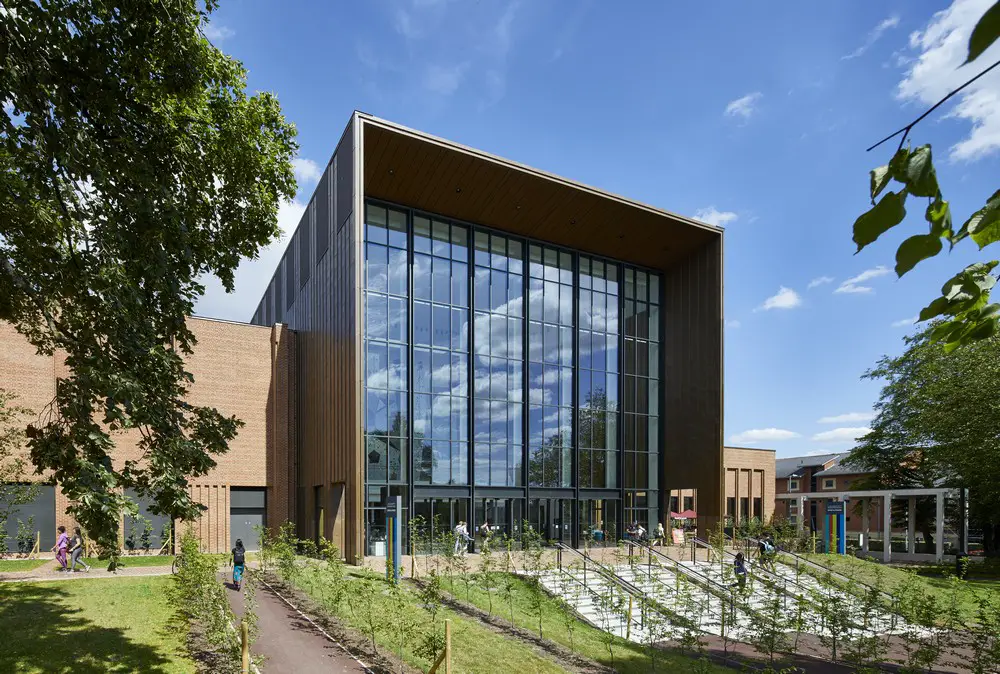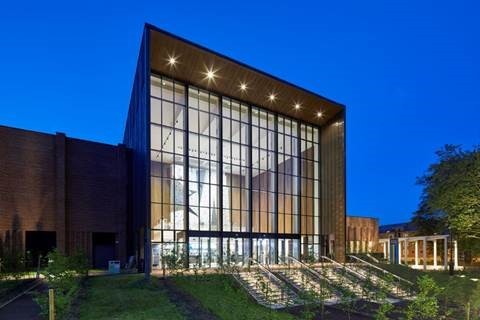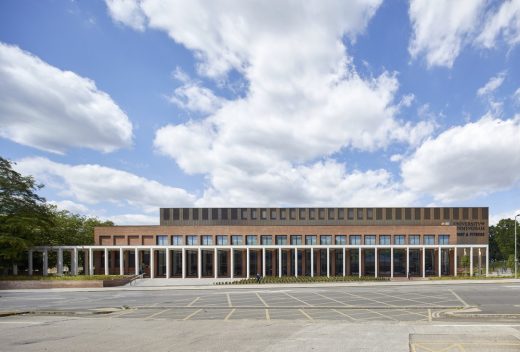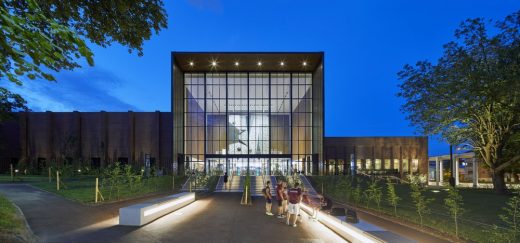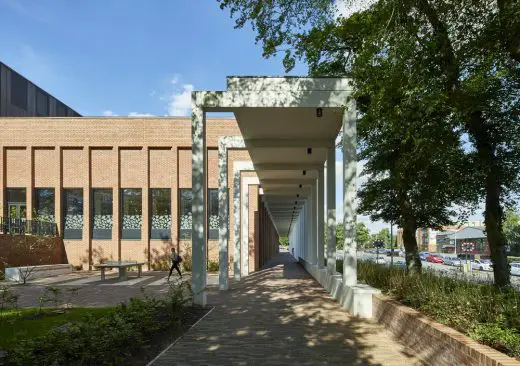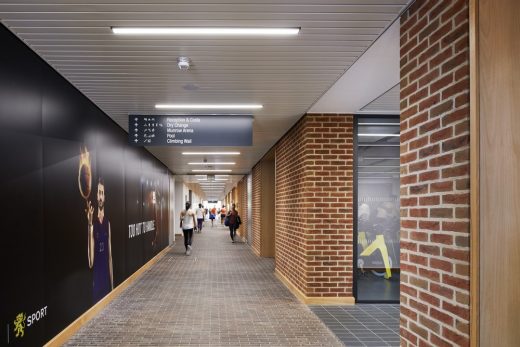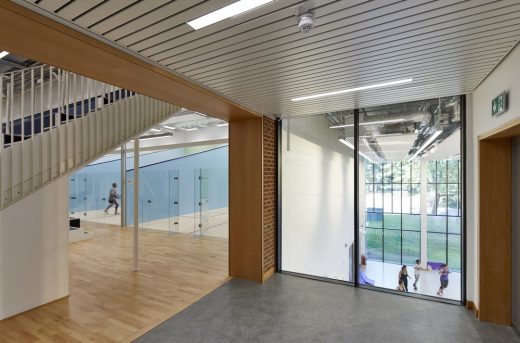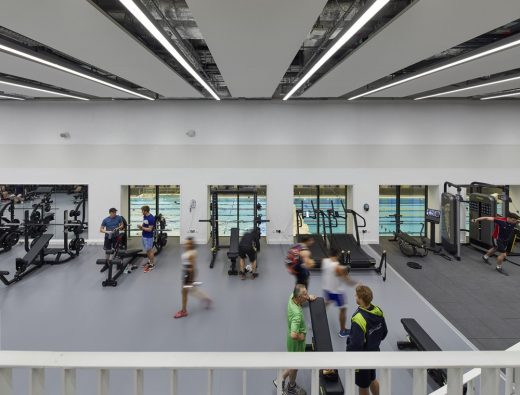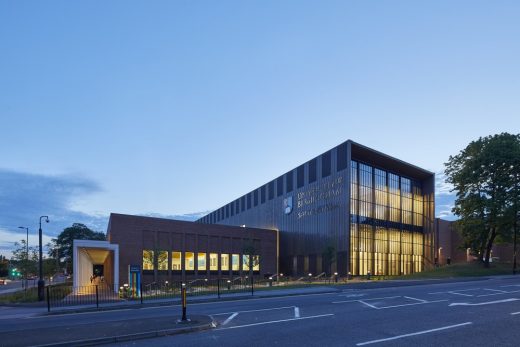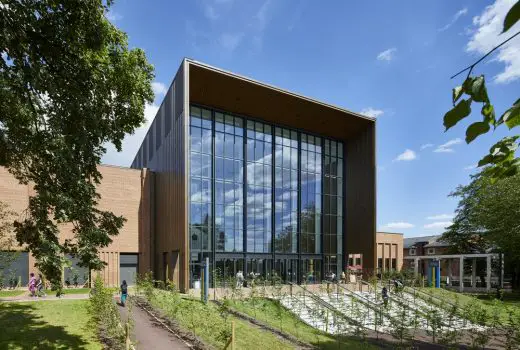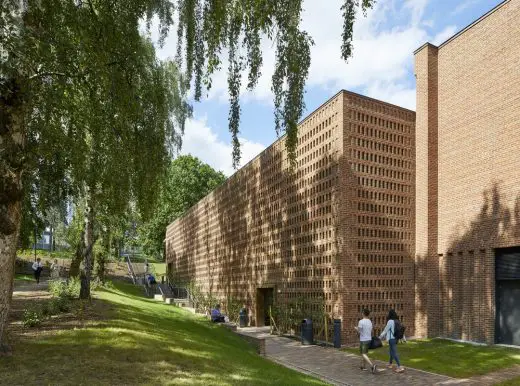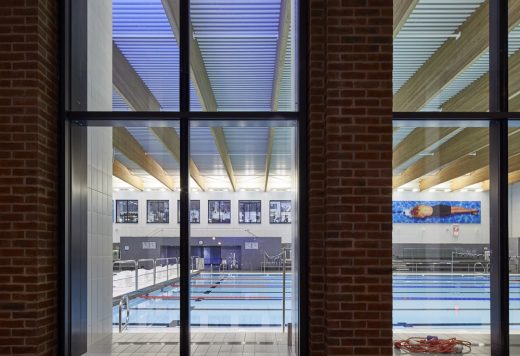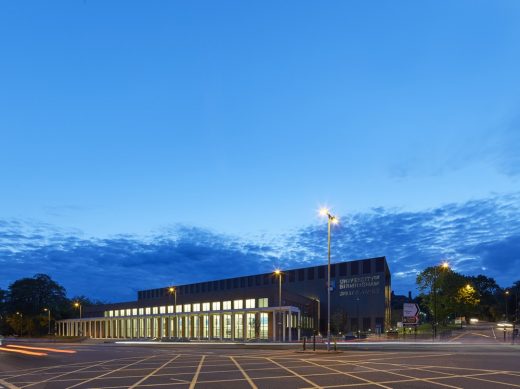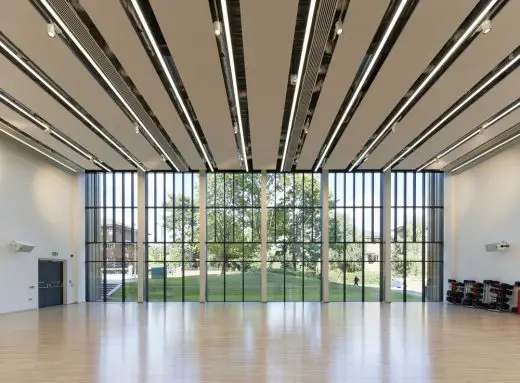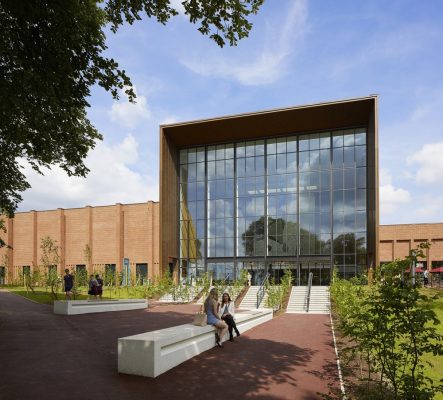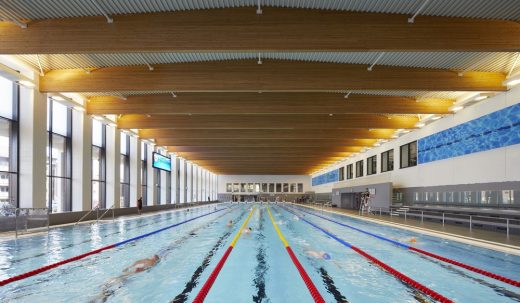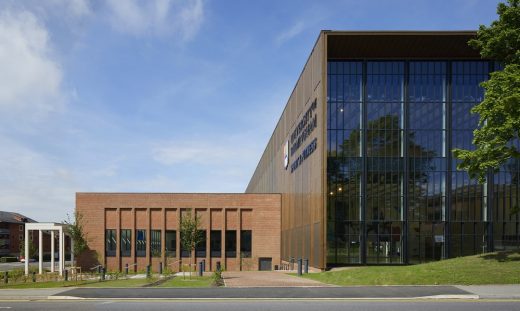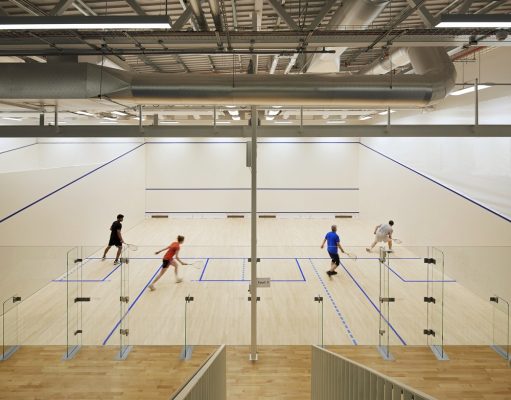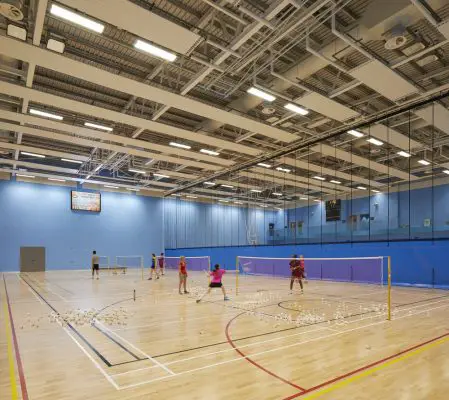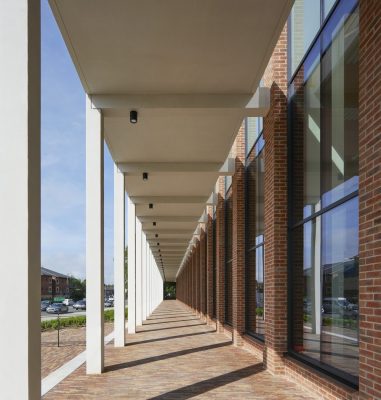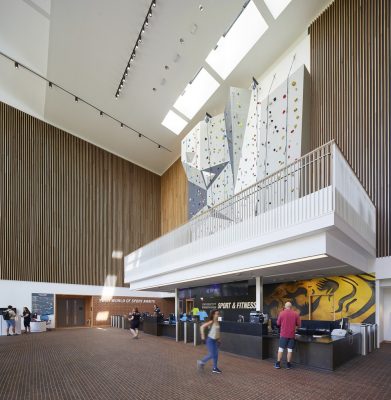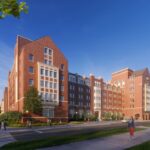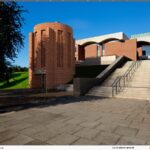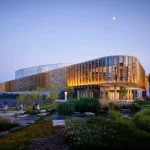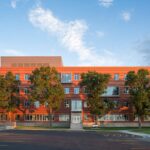University of Birmingham Sports Centre Development, Building Images
University of Birmingham Sport & Fitness Club Building
New Sport & Fitness Club in The Midlands design by Lifschutz Davidson Sandilands, England, UK
29 Jun 2018
University of Birmingham Sport and Fitness Centre Award
Design: Lifschutz Davidson Sandilands Architects
Location: University of Birmingham, West Midlands, England
University of Birmingham Sport and Fitness Centre wins National RIBA award
Lifschutz Davidson Sandilands’ (LDS) new sports centre for the University of Birmingham has been named as one of two National RIBA award winners in the West Midlands, marking it as one of this year’s finest buildings in the UK.
The building, already a recipient of a Civic Trust Commendation and a West Midlands Property Award was formally opened by Her Royal Highness The Princess Royal in March. It was a key component of the city’s successful bid for the 2022 Commonwealth Games where it will host Commonwealth squash, alongside Commonwealth hockey on the neighbouring pitches. In its first year Sport and Fitness has attracted more than 10,000 members and welcomes more than 1,000 school children each week for swimming lessons.
Photos by Paul Riddle
The judges citation concluded, ‘Since opening, the centre’s membership from both university and town has surged, exceeding all expectations – a fitting recognition of the client’s vision and the way it has been given form by the architects (LDS). The new centre provides a broad range of highly flexible and well equipped spaces that can be adapted for different sports and public events, a level of adaptability that in other sports facilities can sometimes result in a dullness of character, but here it is achieved with memorable civic spirit.’
Architect Paul Sandilands commented, ‘We’re thrilled to receive this award – It is a wonderful project on so many levels – a civic gateway to the Aston Webb campus, a highly sophisticated university sports destination, yet also a place for the people of Birmingham.’
Director of Sport Zena Wooldridge said: “This is fantastic news. I’m delighted for the whole team involved in conceiving, designing and constructing such an impressive building. It’s not just the physical design and appearance of it, but it has a lovely welcoming feel to it too. It’s a building people love being in, and creates a sense of well-being and community. We’re very lucky to have such a magnificent building, and very proud it won a RIBA award.”
Simon Shakespeare, the University’s Deputy Head of Capital Programme, said: “This is a great result for such a major project here at the University. It really marks a transformation in the quality of facilities we are able to provide, and sets out our intentions for the future of this campus.”
The Sport and Fitness Club is part of a £600 million investment in the University of Birmingham’s campus, with a vision to provide state-of-the-art facilities to students and staff for generations to come.
University of Birmingham Indoor Sports Centre information received 290618
25 + 21 Sep 2017
Birmingham Indoor Sports Centre Building
Design: Lifschutz Davidson Sandilands Architects
Location: University of Birmingham, West Midlands, England
Lifschutz Davidson Sandilands completes Indoor Sports Centre at the University of Birmingham
One of the UK’s most ambitious indoor sports facilities opens.
The Indoor Sports Centre at the University of Birmingham will provide future generations of the city’s athletes with world-class sports facilities. Open to students, academics and the public, the Centre incorporates Birmingham’s first Olympic-standard swimming pool, together with a range of sports halls and gyms, laboratories and testing facilities.
The project also meets ambitious energy performance targets, particularly for a swimming pool, and makes optimum use of natural light.
For Zena Wooldridge OBE, Director of Sport at the University of Birmingham, the opening of the new facility is the culmination of 10 years’ planning; she says:
‘The stature of this new building reflects Birmingham’s position as a leading global sporting University, both academically and across the range of sport and fitness opportunities for participants of all ages and aspirations. It is a magnificent building, and has received amazing feedback since it opened. Our aim is to provide a fabulous sport and fitness experience, not just via the quality of the facility, but also through the huge choice and the quality of programmes and the expertise of our staff. The whole project is designed to enhance the quality of life in our community.’
Lifschutz Davidson Sandilands director, Paul Sandilands, who oversaw the project says:
‘It is a wonderful project on so many levels – a civic gateway to the Aston Webb campus, a highly sophisticated university sports destination, yet also a place for the people of Birmingham.’
Located on a former brownfield site, adjacent to the Edgbaston Conservation Area, the Centre forms a gateway to the University’s Edgbaston Campus and expresses a welcoming civic identity on the busy A38, which runs along the site’s southern boundary.
The building’s considered composition is matched by a subtle landscape strategy, which responds sympathetically to the existing context and a dramatic change of levels, to connect the city to the heart of the University campus, located some 10m above.
Formally, the scheme is articulated as discreet volumes, detailed in brick and bronze. Each of these four elements is devoted to a separate use – swimming pool, gym and changing rooms, sports halls, and car park – and the volumes shift in plan and section in response to the topography and to articulate the entrance.
The swimming pool is placed prominently to the south, to signpost the Centre and the University beyond. A simple arrangement of spaces and structure gives the building inherent flexibility, while the staggered plan allows any of the volumes to be extended easily in the future.
A public colonnade encourages informal access to the building, and onward to the campus, and provides an invitational glimpse of the swimming pool through a glazed double-height façade. Once inside, there are views between the pavilions, the gym, pool and sports hall, and the reception desk is surmounted by a dramatic climbing wall.
Sustainability at University of Birmingham Sport and Fitness Centre
The scheme is designed to achieve an Environmental Performance Certificate rating of ‘A’ and a BREEAM ‘Excellent’ rating. The four pavilions combine to form a virtually square plan with excellent wall-to-floor-area ratio. Each is laid out to provide the optimum arrangement for its particular sport. Each element has an efficient and flexible layout – the result being that a relatively modest budget has afforded an unusually high quality of workmanship and material.
The simple internal layout of spaces and structure, together with an inherent flexibility, is an important aspect of the Centre’s sustainable credentials; embodied energy in fabric and structure equates to many years of carbon used in operation.
Good daylight in the heart of the building significantly reduces the projected CO2 emissions by artificial lighting and greatly enhances the user experience. Natural ventilation in spring and autumn will also reduce energy consumption.
University of Birmingham Sport and Fitness Centre photos below by Hufton and Crow:
In summer, cool night air is introduced into the building to lower the temperature of the exposed thermal mass of the fabric and to damp heat gains the next day. When large crowds of spectators attend the sports hall, a natural ventilation ‘boost’ facility, powered by dedicated PV panels, improves summer conditions. A heat-recovery system also allows the ‘boost’ to be used in winter.
The services are laid out to facilitate future upgrades to meet changing environmental standards with minimal disruption. The development is slated to achieve the first EPC ‘A’ rating for a sports centre in the UK and a BREEAM ‘Excellent’ rating through a host of measures including very low U values for its envelope, connection to the university’s district heating system and a very onerous air tightness of 3m3/h/m2 @ 50Pa achieved with the assistance of a specialist airtightness consultant.
Birmingham Indoor Sports Centre – Building Information
Team
Client: University of Birmingham
Architect/Lead designer: Lifschutz Davidson Sandilands
Sports consultant: S+P Architects
Cost consultant: Robinson Lowe Francis (RLF)
Structural engineers: Arup
Service engineers: Couch Perry and Wilkes LLP (CPW)
CDM-C: Steven Barnsley Associates (SBA)
Sports Consultee: Sport England
Building Control: ACIVICO Building Consultancy
Landscape Architect: Townsend Landscape Architects
Fire: Jeremy Gardner Associates
Transport / Highway WSP Property and Development
Environmental engineer: WSP Environment
Flood risk: WSP Property and Development
Accessibility consultant: People Friendly Design
Acoustic engineer: Cole Jarman
Air tightness: BSRIA
Filtration engineer: Devin Consulting
Planning Consultant: Turleys
Climbing walls: DR climbing
Facts and Figures
• £35 million construction cost
• 142,000 sq ft (13,205 sq m) GIA
• 1.88 hectare site area
• 50m Olympic swimming pool with moveable floor and boom
• 2,000 sqm multi-purpose arena and sports hall with 780 bleacher seats
(appropriate for 12 badminton courts / 12 competition table tennis courts / 3 netball or basketball courts)
• 6 squash courts (3 of them are show courts with 200 spectator seats)
• 200 + station gym
• 2 large activity rooms
• 300 sqm Dojo can be used for a range of martial arts classes and training
• Climbing wall in reception
• Sports performance laboratories, treatment rooms, rehab and assessment suites
• Spa
• 270 car parking spaces
• Primary materials are brick, bronze, acid etched pre-cast concrete, timber
• Estimated c90,000 bricks
• 2 million litres of water in the pool
• 45 minutes to change from 25m to 50m pool
The University of Birmingham
The University of Birmingham (informally Birmingham University) is the oldest red brick university in the United Kingdom a founding member of both the Russell Group of British Research Universities and Universitas 21, the international network of research universities.
It was ranked 11th in the UK and 64th in the world by QS World University Rankings. In 2013, Birmingham was named ‘University of the Year 2014’ in the Times Higher Education awards. Birmingham is also ranked 4th in the UK for Graduate Prospects in The Times and The Sunday Times Good University Guide 2015, higher than University of Oxford and the London School of Economics. The student population includes around 19,000 undergraduate and 9,000 postgraduate students, which is the 11th largest in the UK.
Lifschutz Davidson Sandilands
Lifschutz Davidson Sandilands was established in 1986 and operates from a Grade II listed building in West London, formerly the home of Island Records.
Its portfolio encompasses residential, workplace, urban design and masterplanning, interior design, retail and restaurants, as well as education and community buildings. Lifschutz Davidson Sandilands has won over 80 awards including ‘London Architect of the Year’ in 2015, the 2016 Mayor’s Housing Design Award, a 2017 RIBA National Design Award for its Paradise Gardens project and the Best New Public Space, 2017 at the recent London Planning Awards.
The architecture practice, together with American light artist Leo Villareal, recently won the international Illuminated River competition lighting 15 Thames bridges in central London and they are currently working on the Institute of Future Living, the first phase of the new campus for UCL in East London.
As well as an established reputation for innovative design, the practice is known for its creative adaptation of historic buildings, from the Oxo Tower refurbishment of the 1990s to more recent interventions, notably the acclaimed transformation of Foyles Bookshop’s flagship store and auctioneer Bonhams New Bond Street Headquarters.
University of Birmingham Indoor Sports Centre Building images / information received 210917
Website: University of Birmingham Indoor Sports Centre
Location: University of Birmingham, West Midlands, UK
Birmingham Architecture
Birmingham Architecture Tours : West Midlands Buildings Walking Tour by e-architect
Public Realm at Birmingham’s Arena Central Development
Architects: Gillespies
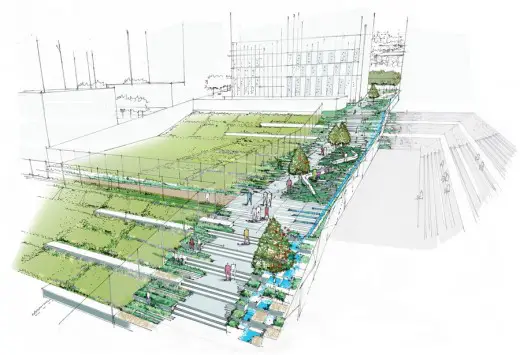
image from architects
New Public Realm for Arena Central in Birmingham
NIA Birmingham
Architects: Broadway Malyan
NIA Birmingham
Architects: Make
The Cube Birmingham
Birmingham Library
Design: Mecanoo
Birmingham Library building
Birmingham New Street Station
Design: Foreign Office Architects
Birmingham Station Building
The Public, West Bromwich
Design: Will Alsop
The Public Art Centre
Selfridges Birmingham : see also Bullring
Design: Future Systems Architects
Selfridges Birmingham
Buildings / photos for the University of Birmingham Sport and Fitness Centre Building page welcome
Website: University of Birmingham

